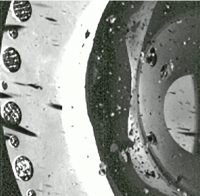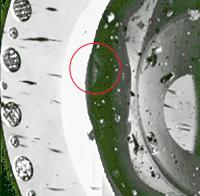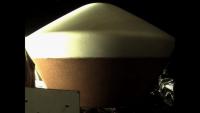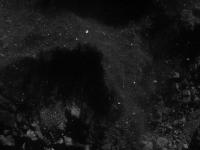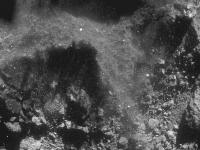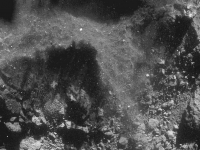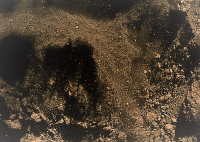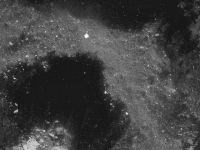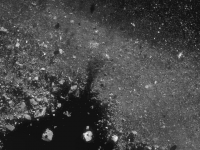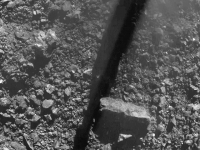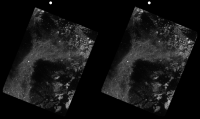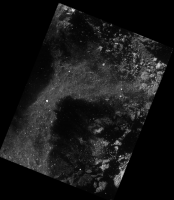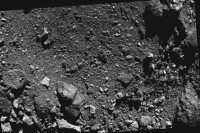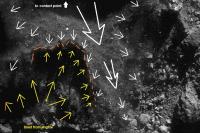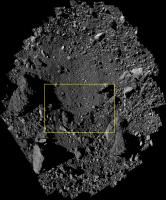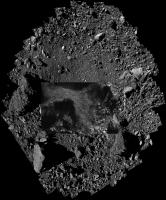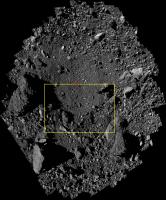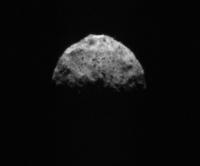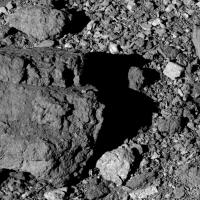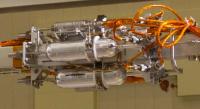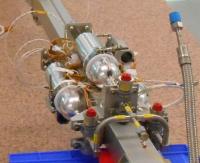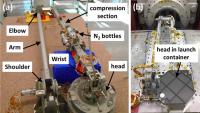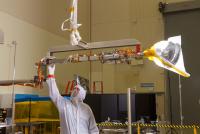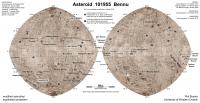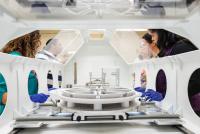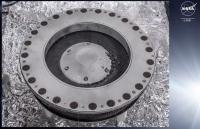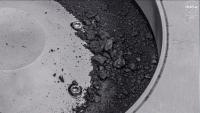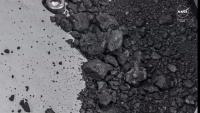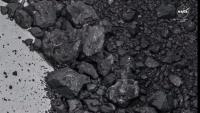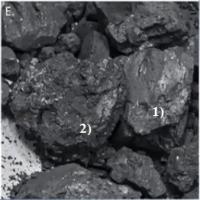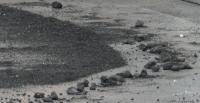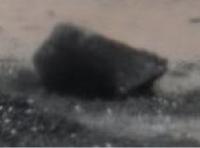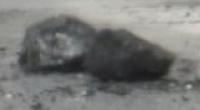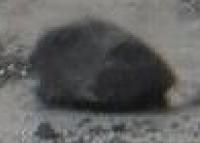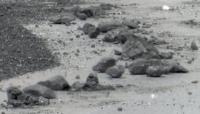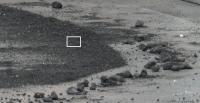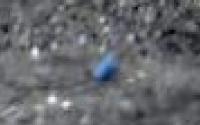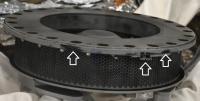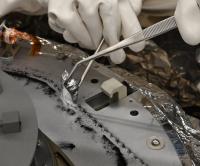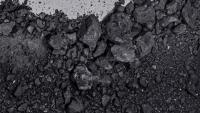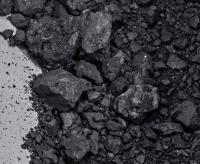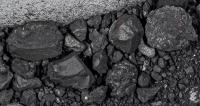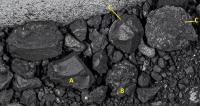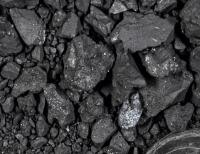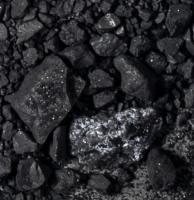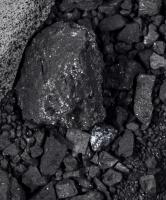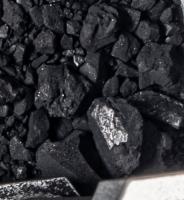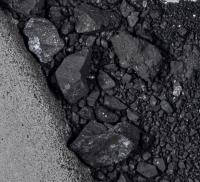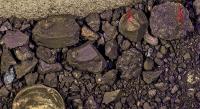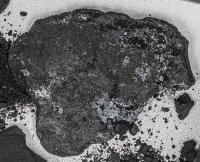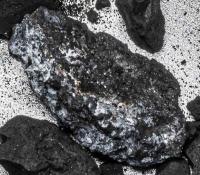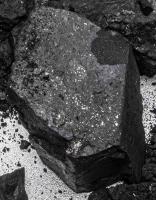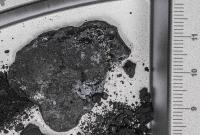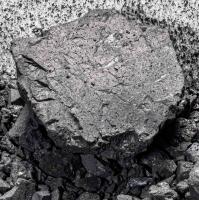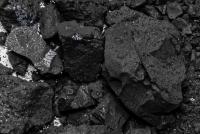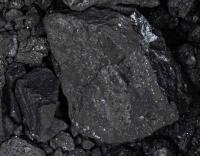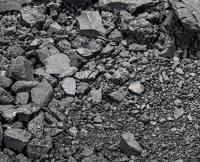Printable Version of Topic
Click here to view this topic in its original format
Unmanned Spaceflight.com _ OSIRIS-REx _ Earth Return & Sample Science
Posted by: nprev Oct 24 2020, 07:02 AM
Now that the 'boop' has been completed (with spectacular success!), we'll move the discussion to here for subsequent mission events. ![]()
Posted by: walfy Oct 24 2020, 08:37 AM
Boosted the shadows to reveal what I assume are the rocks wedged in the mylar flap. Looks like our little robot gorged like a T-REx!
The third image in the sequence was the most over exposed, so the rocks hiding in the shadows are the least grainy when revealed:
Posted by: dsmillman Oct 24 2020, 01:30 PM
The audio of the 10/23/2020 teleconference can be accessed for 30 days at:
1-866-373-4996
Posted by: Tom Tamlyn Oct 24 2020, 06:55 PM
Thanks to for that link.
It was a great press conference. Even though Brian's http://www.unmannedspaceflight.com/index.php?s=&showtopic=8413&view=findpost&p=248361 covered most of the the major points, it made fascinating listening, with detailed, clear, and fluent presentations and answers from Dante Lauretta and Thomas Zurbuchen, and sharp, business-like questions from well-informed reporters.
The stow operation is currently expected to begin on Tuesday. As Brian mentioned, the mission is seeking substantial extra DSN coverage in order to do something unusual for robotic spacecraft: conduct an operation interactively with "the ground in the loop." The revised stow plan will have a number of check points, at which the operation will pause while images are downloaded and analyzed to determine whether to proceed with the plan or try something different. As a result the stow operation is expected to last three days, instead of several hours as originally planned.
The previously scheduled activity of spinning the spacecraft with the arm extended to obtain a moment of inertia measurement has been cancelled, and Lauretta pretty much ruled out any other possibility for measuring the sample mass (as opposed to estimating the mass from images) prior to landing. However, he did seem to acknowledge that there had not been any occasion to think about a different way such a measurement could be taken during the return trip. I suppose it's possible they might come up with a way to tease some sample mass information out of trajectory telemetry during the return voyage.
Posted by: JRehling Oct 24 2020, 07:24 PM
Looking at the apparent fragility of those "rocks" I wonder what is going to happen during the high g forces during entry. None of it will vanish, but it might lose some of the original structure.
Posted by: marsbug Oct 24 2020, 09:18 PM
It's a nice problem to have in a way... but it's still a problem . Still it sounds like the team have it in hand.
Posted by: Explorer1 Oct 24 2020, 09:56 PM
Assuming the mass without the sample (including fuel and subtracting the nitrogen gas used) is known precisely enough, there should be a slight difference in how it 'handles' during maneuvers like the Earth return burn and any TCMs.
Posted by: dtolman Oct 24 2020, 10:42 PM
So they cancelled the spin because visual inspection confirmed an abundance of material?
Posted by: Marcin600 Oct 25 2020, 12:33 AM
"...To preserve the remaining material..."
"...Any movement to the spacecraft and the TAGSAM instrument may lead to further sample loss..."
"...The loss of mass is of concern to me, so I’m strongly encouraging the team to stow this precious sample as quickly as possible - said Dante Lauretta..."
["some of sample particles appeared to be escaping slowly from the TAGSAM head - passing through small gaps where a mylar flap is slightly wedged open by larger rocks"]
(https://www.nasa.gov/press-release/nasa-s-osiris-rex-spacecraft-collects-significant-amount-of-asteroid)
I think that with very gentle and careful moving the TAGSAM head while enclosing it in the return capsule, and doing it without undue delay, the final loss of the collected mass (they collected about 400 g - much more than planned 60 g) will be insignificant. We have to keep our fingers crossed for this
Posted by: Reed Oct 25 2020, 06:32 AM
FWIW, also on youtube (starts at ~13 minutes) https://www.youtube.com/watch?v=n274YX4xk_0 - just audio except for showing the gif from the press release for a while
Posted by: rlorenz Oct 25 2020, 10:16 PM
In theory, yes (I think I remember reading a scifi story where a stowaway on a spacecraft is discovered this way). But in practice, this is a very small signal to look for (if you want to measure a 400g sample to 10%, as part of a 400kg spacecraft, that's a 0.01% precision)
I think thruster performance is probably not more consistent than 1%, maybe worse.
Measuring spin rates, and changes therein is something that can be done with exquisite precision, but more particularly putting the sample mass out on the TAGSAM arm gives a large moment arm, so the sample mass 'signal' component of the vehicle's moment of inertia. So having a viable retrieval of sample mass from this spin exercise does not mean you can do it with useful precision in a translation manoeuvre....
Posted by: mcaplinger Oct 25 2020, 11:21 PM
Agreed, I don't think thruster firing is going to tell you anything.
But the other small forces on the spacecraft (e.g., radiation pressure) might be well enough characterized. Time will tell.
The story is of course https://en.wikipedia.org/wiki/The_Cold_Equations
Posted by: JRehling Oct 26 2020, 03:58 AM
Apollo 13 had a bit of a concern regarding sample mass, but it was an issue of many kg, not g:
http://www.collectspace.com/news/news-041620a-apollo13_50th_moon_rocks_souvenirs.html
Posted by: stevesliva Oct 26 2020, 01:50 PM
Any word on this? I wonder in the context of an extended mission (proposal? idea?).
Posted by: jccwrt Oct 26 2020, 05:39 PM
If Bennu regolith is anywhere near as sticky as lunar regolith, that whole part of the spacecraft is probably filthy from the compressed nitrogen burst.
Posted by: Explorer1 Oct 26 2020, 08:41 PM
Expedited stow begins tomorrow. Images will be returned at each step. https://www.nasa.gov/press-release/nasa-s-osiris-rex-spacecraft-goes-for-early-stow-of-asteroid-sample
Posted by: Marcin600 Oct 26 2020, 09:42 PM
An excerpt from Dante Lauretta speech about the dust on the camera - https://www.youtube.com/watch?v=n274YX4xk_0 [44:50 - 45:35]:
„...We have seen that there is dust loading on our other optical elements, the navigation camera... and the sam cam which used to document the interaction with the asteroid surface. So we do need to know the state of that camera. And the dust loading isn’t a problem, it just changes the exposure times. I like to think about, you know, when you’re wearing glasses and the glasses are pretty dirty, you don’t really notice it until you take the glasses away and look and clean them, but not as much light as passing through those lenses, so you just need to stare integrate the camera time longer for that activity. So that is one reason and one thing we plan on doing on monday, is checking out the camera. So we’re hoping to begin the stow activities on tuesday...”
Posted by: HSchirmer Oct 27 2020, 12:20 AM
More worrisome is whether they will be lost in a "burp" when the sample return container is opened.
Second, (I haven't read the sample return protocol, so excuse the presumptions, BUT) I'm hoping they're going to amend the sample retrieval process to include dropping the sample return capsule in mylar-kevlar and then dunking the entire sample return into liquid nitrogen to prevent any further decomposition of clathrates or loss of volatiles.
Third, this sounds like a WONDERFUL opportunity to seek funding for a "WildFire" sample analysis module on the ISS. Something where you could keep samples in a micro-gravity environment, at cryogenic temperatures, while "decanting" them from probes.
Posted by: HSchirmer Oct 27 2020, 12:23 AM
"The Cold Equations" https://docs.google.com/viewer?a=v&pid=sites&srcid=ZGVmYXVsdGRvbWFpbnxiY2hzbXJlcmlja3NvbnxneDo5NjI5MmU1OTQ2YWViOWY
Posted by: pbanholzer Oct 27 2020, 01:10 AM
Here's an article on contamination control for the SRC. Capturing/identifying sample outgassing is addressed in section 7.2 (and maybe other places I didn't catch).
https://www.ncbi.nlm.nih.gov/pmc/articles/PMC6350808/
Posted by: Hungry4info Oct 28 2020, 10:47 PM
OSIRIS-REx in the Midst of Stow
https://www.asteroidmission.org/?latest-news=osiris-rex-in-the-midst-of-stow
Posted by: Marcin600 Oct 29 2020, 05:05 PM
NASA will host a media teleconference at 4 p.m. EDT (8 p.m. = 20:00 UTC) today, Thursday, Oct. 29 - stream live at: http://www.nasa.gov/live
"During the teleconference, OSIRIS-REx team members will discuss how the stowage process has gone so far, what else they have learned about the sample, and what the next steps are for the mission to return the sample to Earth." (https://www.nasa.gov/press-release/nasa-invites-media-to-briefing-on-osiris-rex-asteroid-sample-stowage)
Posted by: Marcin600 Oct 29 2020, 08:52 PM
From teleconference: 400 g was visible in the camera, but they calculate that in reality there is currently maybe even well over 1 kg of samples in the TAGSAM head !!!
Most of the visible rocks (in the photos - flying around the TAGSAM head) are very flat - like corn flakes
The parcel is now packed and ready to ship to Utah:
Posted by: Explorer1 Oct 29 2020, 09:03 PM
Dante just said that the navcam was taking images (not yet released) that will show some of the surface effects from the thrusters and direct contact. So even if there's no return to Bennu's proximity, there should be some neat before/after images to look forward to.
Posted by: Marcin600 Oct 29 2020, 09:25 PM
From teleconference (+/-): "...The fact that TAGSAM has penetrated about 48 cm into regolith shows that the cohesive forces in regolith are very, very weak. There is almost no force between the crumbs that hold them together. The TAGSAM head sank in the regolith like in fluid...The same would happen with astronauts who would try to walk on an asteroid - they would sink into regolith to a depth depending on whether they were standing on loose soil, on a boulder or on some bedrock..."
https://www.youtube.com/watch?v=8kJLM87KGgQ&feature=emb_logo (starts around 13:27)
49:00 - 50:30
Posted by: Marcin600 Oct 29 2020, 10:16 PM
From teleconference (+/-): "...The ship's return engines left clear marks on the surface and launched a lot of debris... The regolith deeper below the surface appears to be composed of much smaller fragments than those visible on the surface..."
https://www.youtube.com/watch?v=8kJLM87KGgQ&feature=emb_logo (starts around 13:27)
1:07:24 - 1:09:55
Posted by: Marcin600 Oct 30 2020, 06:05 PM
Once again Dante Lauretta statement about Bennu's regolith, this time I post an exact transcription from https://www.youtube.com/watch?v=8kJLM87KGgQ&feature=emb_logo (47:17 - 51:22):
Ivan Carone (AFP): „What have you learned from Bennu’s soil thanks to this operation and, to make it simple, if someone was to walk on Bennu what do you think it would be like?”
Dante Lauretta: „(...) i’ll just go back a little bit in time here and then and I did this after the TAG event I went back to a science team meeting from 2014 where we were discussing the possible interactions of TAGSAM with the Bennu soil or the regolith during the collection event. We had multiple teams trying to model this process. It seems like it should be straightforward but it’s actually pretty chellenging because you’re in a microgravity environment and all of the literature and all the previous studies that we were looking at the gravity field is a major component in describing the soil behavior in response to various forces. So, the question we were grappling with is how does the soil beheve when you remove gravity from the equation and all the other forces start to play a role. We’re particulary interested in understanding the cohesive forces between grains and any frictional forces that could arise due to the compression. The predctions ranged from we would penetrate three meters to we would penetrate three millimeters! So, it was really not helpful for me, except that we had a kind of a range of predictions based on inferred regolith properties.
Since we penetrated, we estimate, about that 48 cm, that’s much much closer to a very low cohesion regolith model. Basically there’s almost no forces between the grains that keep them bound together. They are not sticking to each other in any way. So when you slide two grains past each other there’s no force that really seems to be measasurable that’s prohibiting that motion. So, when the TAGSAM head made contact with the regolith, it just flowed away like a fluid.
And I think that’s what would happen to an astronaut if she were to attempt to walk on the surface of the asteroid. She would sink to her knees or deeper, depending on how loose the soil was until you hit a larger boulder or some kind of bedrock.
So, that’s already I can guarantee you the team is off now that we have this ground truth calibration data set to re-evaluate models of asteroid geology, and especially soil response and soil creep, and mass wasting, and other movements on the surface of the body. So, it’s fascinating that there was so little resistance to the spacecraft from the asteroid surface. Basically it’s kind of like a ball pit at a kid’s playground right you kind of jump into it and you just sink in. And that’s what the spacecraft did. And so luckily we had those back away thrusters to reverse the direction of motion, or we might have just flown all the way through the asteroid ![]() "
"
Ivan Carone (AFP): "But do you think it could go very deep, like this kind of low cohesion?"
Dante Lauretta: "Yeah, I believe the model suggested, like I said, to three meters of penetration in a completly cohesionless environment, and that seems to be the way the soil responded. We were moving at almost full velocity after we made contact, and the deceleration that we experienced before the back away thrust was primarily from the TAGSAM, recall that the TAGSAM collects material by ejecting nitrogen gas, it’s basically like a cold gas thruster. And if we hadn’t done that and we hadn’t fired the back way thrusters, there was no resistance that’s measurable coming from the actual asteroid regolith."
Posted by: mcaplinger Oct 30 2020, 06:40 PM
While waiting for these (I have no idea when they will be released) one could amuse oneself figuring out what they might look like relative to the SamCam images (SamCam is 20x20 degrees and basically pointed at the TAGSAM head); Navcam1 has an FOV of 21x16 degrees and is rotated 6 degrees about Y and -70 degrees about Z. I've never seen a good visualization of this and it's pretty confusing. All of this stuff is in https://naif.jpl.nasa.gov/naif/data_comet.html [EDIT: these images were taken with what is being called Navcam 2 or NFTCam; we called it Navcam1 when we were building it, but I guess they swapped the numbers?]
Posted by: Hungry4info Oct 30 2020, 09:59 PM
Absolutely spectacular video of the sampling. We see the ejecta blanket expanding away from the impact site and creating the massive shadow we saw earlier. I've uploaded one of the frames. This is amazing. Best thing I've seen since the New Horizons image of Pluto back-lit from the sun.
TAG Captured by NavCam 2
https://www.asteroidmission.org/navcam2_tag_single_loop_complete_small_gif/
Posted by: Marcin600 Oct 31 2020, 01:29 AM
A little lightened. Could it be a crater? (dug by one of the return engines)
Posted by: FOV Oct 31 2020, 01:37 AM
I agree Hungry4info. Spectacular. My messing about with filters and such.
Posted by: Explorer1 Oct 31 2020, 02:22 AM
Wow! dusting off the old swear jar! The liquid metaphor from the telecon is a great description, it really looks like its seething. Spaceflight image of the year!
Too bad about not returning to Bennu to see the wider view, but a bird in the hand (or SRC) is worth two in the bush, as they say.
Posted by: Marcin600 Oct 31 2020, 02:29 AM
the second stage
I wonder if all these thin, elongated shadows (almost black, thick lines) are the silhouettes of flat grains of regolith right next to the camera?
Posted by: Brian Swift Oct 31 2020, 07:25 AM
Before and After. Frames 274 and 469 from NavCam2_TAG_single_loop_complete_small_gif.gif.
"After" frame has been brightened by 2.5x to better match "before".
The rocks(boulders?) along the right and bottom edge of "after" image can be matched to "before" image which covers a somewhat wider area.
Posted by: Marcin600 Oct 31 2020, 12:27 PM
"After" frame has been brightened by 2.5x to better match "before".
The rocks(boulders?) along the right and bottom edge of "after" image can be matched to "before" image which covers a somewhat wider area.
Looking at this brilliant before-after compilation, it now seems to me that all these dark areas and other things are happening on or above the surface, and that it is not a crater or a depression after all.
PS Of course except the pre-existing shallow crater (the target of the operation). These black areas can be hanging clouds or spots of very fine, dark debris (?)
Posted by: Greenish Oct 31 2020, 04:54 PM
Agree that these are fantastic images, most inspiring to get engaged with for me since some of the early Curiosity stuff.
Dusting off some of my tool from then (like StereoPhotoMaker, which has improved!) here's some quick pseudo-3D views from nearby frames at the end of the sequence. Contrast stretched.
Cross-eye view
"Rotating illusion" gif (click to animate)... this one I turned 90 deg because it was easier for me to visually process.
Posted by: Greenish Oct 31 2020, 06:01 PM
And here are two more, from adjacent frames (no shadow appearing suddenly and the disparity is less exaggerated). Also rotated so the motion is ~horizontal to align with eye separation.
crosseye:
gif:
PS Of course except the pre-existing shallow crater (the target of the operation). These black areas can be hanging clouds or spots of very fine, dark debris (?)
From these shots it appears to me that the dark areas are shadowed by the curtain of suspended material. What look like streaks of light under the "sheet" of particles are really cool, and there does appear to be a depression. Edit: The center of the impact zone is at about at the edge of the frame by this part of the sequence.
Posted by: Marcin600 Nov 1 2020, 01:05 AM
My attempt to make "before-and-after" animation (frames: 279 and 476):
Posted by: Marcin600 Nov 1 2020, 02:29 AM
Now it looks to me as if a cloud of debris was coming from the top of the photo (from the sampling site) and was being pushed from the bottom left corner (by the engine blast?). A black veil is created where the cloud thickens (on the border of the interaction of these two forces). This thickened veil also seems to cast a shadow towards the left and bottom of the photo...
This is just my speculation.
Posted by: Greenish Nov 1 2020, 04:46 AM
Animated movie of the 'blast,' starting from where ground becomes visible again.
Full-res all frames here: https://imgur.com/a/Wp8swJD... had to make it pretty small, and use every other frame, to upload here as a GIF.
(I did NOT think this would work. All the hard part done by those who implemented the SIFT-based stack alignment tools in ImageJ! It is quite possible there are some distortions, but I'm learning as I go.)
Posted by: monty python Nov 1 2020, 05:31 AM
Wow Greenish! Emptied my wallet into the swear jar.
Posted by: Guillermo Abramson Nov 4 2020, 12:23 PM
Oh, this is the one that convinced me. Thanks!
Guillermo
Posted by: Marcin600 Nov 4 2020, 05:12 PM
Full-res all frames here: https://imgur.com/a/Wp8swJD... had to make it pretty small, and use every other frame, to upload here as a GIF.
(I did NOT think this would work. All the hard part done by those who implemented the SIFT-based stack alignment tools in ImageJ! It is quite possible there are some distortions, but I'm learning as I go.)
I just can't stop looking at this movie. Outstanding compilation!!!
Although the movement of the cloud relative to the surface is probably slightly exaggerated (?) by the movement of the camera and the associated change in the angle of view, you can still see the huge dynamics of the debris! And this amazing creep of shadows on the surface! It looks a bit like a version of a dust storm with large stones in it. Very unique and informative shots!
I would love to see what's in the black area at the top and outside of the pictures, in the place where TAGSAM "touched" the surface. I wonder if we will see such pictures from a distance?
Posted by: Marcin600 Nov 14 2020, 04:35 AM
My rough attempt to put the post sampling picture in the context of Nightingale, including scale and orientation of the picture.
I used https://www.asteroidmission.org/nightingale-recon-c-mosaic-reduced-size/ and frames 279 and 476 of the https://www.asteroidmission.org/navcam2_tag_single_loop_complete_small_gif/.
As the shots from NavCam 2 were taken slightly obliquely to the Bennu surface, there is a shortening of the perspective compared to the mosaic and some view distortion.
Posted by: Marcin600 Nov 14 2020, 04:37 AM
And also an attempt to superimpose a post sampling picture on the Nightingale mosaic
Posted by: Marcin600 Nov 17 2020, 08:55 PM
SamCam and NavCam 2 Imaging Footprint During TAG - https://www.asteroidmission.org/tag_cpe/
Posted by: Marcin600 Nov 18 2020, 09:36 PM
I added my own interpretation of the TAGSAM head touch point location to my previously posted OSIRIS-REx photo compilations (based on newly released https://www.asteroidmission.org/tag_cpe/)
Posted by: Marcin600 Jan 19 2021, 08:19 PM
Considerations on the extended OSIRIS-REx mission to Apophis:
https://www.space.com/osiris-rex-asteroid-probe-could-visit-apophis-2029 :
„...scientists behind NASA's OSIRIS-REx asteroid sample-return mission are contemplating sending the spacecraft to study a second asteroid in 2029, this time the infamous Apophis. If that appointment comes to be, the spacecraft will arrive at Apophis in April 2029...
The OSIRIS-REx team plans to propose an extended mission to NASA in the summer of 2022, Lauretta said. Visiting Apophis is one option for what that extended mission could look like, but so far, it's the only target that engineers have found the spacecraft could visit long-term...”
Posted by: stevesliva Jan 19 2021, 08:46 PM
*Orbit* Apophis. Wow.
The duration post-sample return is similar to Hayabusa2 XM's discussed starting here:
http://www.unmannedspaceflight.com/index.php?showtopic=4920&view=findpost&p=247738
... so I wonder if it's all Earth flybys, or if Venus is also in the mix.
Posted by: vjkane Jan 19 2021, 11:01 PM
They could even poke the surface with the sampling arm to test its strength (presumably after all other studies are complete).
Posted by: Explorer1 Jan 20 2021, 03:19 AM
I've read about some other proposals for Apophis missions, arriving before the Earth encounter and escorting it to watch for changes both on the surface and from nearby (the views at closest approach would be spectacular, too!). But a spacecraft already launched has so many advantages.
Crossing fingers for approval! It's interesting that they could find no other close encounters in the next 8 years but Apophis. Something about the orbital mechanics being special?
Posted by: JRehling Jan 20 2021, 03:28 AM
2021: Everyone's hoping that Osiris-Rex will have an Apophis encounter in 2029.
2004: Everyone's hoping that Earth won't have an Apophis encounter in 2029.
Posted by: vjkane Jan 20 2021, 04:12 PM
Crossing fingers for approval! It's interesting that they could find no other close encounters in the next 8 years but Apophis. Something about the orbital mechanics being special?
There would be value in closeup imaging of Apophis before its close encounter so that OSIRIS-REx can look for changes caused by the close encounter with Earth, potentially with a cubesat spacecraft.
Also, OSIRIS-REx lacks some standard remote sensing composition instruments such as a gamma-ray spectrometer. (No need for those instruments with sample being returned to Earth.)
There was a conference last year about Apophis and possible missions (including the potential OSIRIS-REx rendevous linked above). See Session 5 for the mission concepts. https://www.hou.usra.edu/meetings/apophis2020/program/apophis2020_program_printed.pdf
Posted by: Explorer1 Jan 21 2021, 12:35 AM
Yes, those are what I read, thanks for finding it! With only eight years until the encounter, the time to start solidifying any proposals is coming up.
This thread is only about O-REx though, so I won't go into those.....
Posted by: Marcin600 Jan 21 2021, 07:48 PM
I guess the author meant (long-term) orbiting an asteroid, not just a close encounter. This probably significantly narrows the possibilities.
[with reduced amount of fuel, only a relatively small difference in orbital velocity between the asteroid and the spacecraft is required...]
Posted by: Explorer1 Jan 27 2021, 04:09 PM
A final Bennu flyby is planned for April to check out the sampling site (not confirmed, but "if feasible")! 3.2 km closest approach, and also an opportunity to check the instruments are working well and not too affected by dust kicked up during the TAG.
https://www.asteroidmission.org/?latest-news=nasas-osiris-rex-mission-plans-for-may-asteroid-departure
Posted by: Marcin600 Jan 30 2021, 03:21 PM
https://www.asteroidmission.org/?latest-news=nasas-osiris-rex-mission-plans-for-may-asteroid-departure
It's a good news !!! I keep my fingers crossed for the OSIRIS-REx team - so that we can see this "battlefield" in April. It's now or never again !
Posted by: Marcin600 Feb 5 2021, 12:57 AM
"The International Astronomical Union (IAU) has approved more names for surface features on Bennu": https://twitter.com/OSIRISREx/status/1356300951942963200
https://www.asteroidmission.org/iau-features-3/
PS. But ... they're not officially listed yet here: https://planetarynames.wr.usgs.gov/SearchResults?target=BENNU Why?
On the OSIRIS-REx website’s map I also can not see such (mentioned in the attached text) surface features, as: dorsa and fossae. Only the new names of the craters have appeared,
i.a. OSPREY is now Wuchowsen Crater; NIGHTINGALE is now Hokioi Crater etc.
Posted by: Marcin600 Feb 9 2021, 01:52 PM
A final flyby of Bennu (and Nightingale) on April 7 is approved !!!
https://www.asteroidmission.org/?latest-news=osiris-rex-to-fly-a-farewell-tour-of-bennu
„...The OSIRIS-REx mission team recently completed a detailed safety analysis of a trajectory to observe sample site Nightingale from a distance of approximately 2.4 miles (3.8 kilometers)...
...During this new mission phase, called the Post-TAG Observation (PTO) phase, the spacecraft will perform five separate navigation maneuvers in order to return to the asteroid and position itself for the flyby. OSIRIS-REx executed the first maneuver on Jan. 14 (...) the spacecraft is now slowly approaching the asteroid and will perform a second approach maneuver on Mar. 6 (...) OSIRIS-REx will then execute three subsequent maneuvers, which are required to place the spacecraft on a precise trajectory for the final flyby on Apr. 7 (...) OSIRIS-REx is scheduled to depart Bennu on May 10...”
Posted by: Marcin600 Mar 8 2021, 08:37 PM
„This image...was taken...on March 4, from a distance of about 186 miles (300 km)...during the mission’s Post-TAG Operations phase, as the spacecraft slowly approaches Bennu in preparation for a final observational flyby on April 7.” - https://www.asteroidmission.org/galleries/spacecraft-imagery/approachingbennuagain/#main
Posted by: Marcin600 Mar 15 2021, 08:22 PM
"...As of Mar. 12, the spacecraft was about 155 km from Bennu and approaching the asteroid at about 24.6 cm/s..." - https://www.asteroidmission.org/status-updates/
Posted by: alan Mar 22 2021, 10:12 PM
Saw this on twitter:
Boulders of all sizes on the surface of the asteroid Bennu, imaged by @OSIRISREx two years ago on March 22, 2019. I inserted a Buzz Aldrin for comparative scale size.
Posted by: Marcin600 Mar 30 2021, 03:55 PM
"The OSIRIS-REx spacecraft... is currently about 30 km from the asteroid... Bennu – traveling approximately 6 cm/s..." - https://www.asteroidmission.org/?mission_update=mar-29-2020
Posted by: Marcin600 Apr 8 2021, 04:31 PM
https://www.asteroidmission.org/?latest-news=nasas-osiris-rex-completes-final-tour-of-asteroid-bennu
„...NASA’s OSIRIS-REx completed its last flyover of Bennu in around 6 am (EDT), 4am (MDT) April 7th and is now slowly drifting away from the asteroid; however, the mission team will have to wait a few more days to find out how the spacecraft changed the surface of Bennu when it grabbed a sample of the asteroid...”
„... It will take until at least April 13th for OSIRIS-REx to downlink all of the data and new pictures of Bennu’s surface recorded during the flyby. It shares the Deep Space Network Antennae with other missions like Mars Perseverance, and typically gets 4-6 hours of downlink time per day...”
Posted by: pbanholzer Apr 10 2021, 07:25 PM
Marc - Thanks for the updates. Do you know what the pressurization of the nitrogen as released ? Oh, and fwiw I retired five years ago from 292.
Posted by: Marcin600 Apr 13 2021, 06:00 PM
I was unable to find information about the exact pressure of compressed nitrogen in 3 cylinders. The descriptions only use the terms compressed nitrogen or pressurized/high-pressure nitrogen bottles. Maybe someone has such data at hand ?
However, we must remember 3 things:
1. When we talk about gas pressure, we mean the pressure under Earth conditions (including the so-called standard temperature).
2. The pressure of the gas depends on its temperature. The colder the gas, the less pressure it has.
3. There is a vacuum on the surface of Bennu. Even gas under "normal" pressure released from the cylinder will behave as compressed gas there.
Here are some quotes found in articles on this topic and pictures of the actual 3 nitrogen cylinders on TAGSAM:
"TAGSAM is the product of Lockheed Martin. The complete TAGSAM design consists of (...) three pressurized bottles containing curation-grade nitrogen gas with a small amount of helium (to check leaks prior to launch)...
There are three independent gas bottles (which are independently released), to support up to three sampling attempts...
Gas handling is passive, operating in the simple blow-down mode...
Sample collection occurs when surface contact is sensed. At this point, a pyro valve opens to a bottle of high-purity nitrogen gas... When sample gas is released from a high-pressure bottle, the gas flows through a feedline to the head and is directed into the regolith via an annular aperture...
The majority of the gas release occurs in 5 sec ...
The gas mobilizes material underneath the head as the gas expands into the regolith. The flange seal and impedance of the soil bed cause the gas naturally to flow from the high-pressure environment underneath the head to the vacuum of space via the collection volume around the perimeter of the head. A screen around the perimeter of TAGSAM retains asteroid regolith, even as the gas escapes...
The propagation of the gas through the regolith likely occurs at hypervelocity speeds for much or all of its expansion. The initial peak speed of the gas while exiting TAGSAM is around 800 m/s. Because the porosity in Bennu's regolith is occupied by a vacuum rather than an atmosphere, the expansion of the gas through the interstitial spaces of the regolith will be a choked flow. In the case of choked flow, the expansion speed of the gas is its sound speed, which depends on gas temperature...
The TAGSAM gas reaches equilibrium with the environment as it expands unto the subsurface. Thus, the temperature of the gas is controlled by the ambient temperature...
The dynamics of the sample gas, and the response of regolith, will be different in Earth-atmospheric and gravity conditions versus those on Bennu...
In the gravity regime, the speed of the nitrogen gas through the regolith spans from the peak speed of release from TAGSAM, ~800 m/s, to the “steady state” expansion of the gas through the subsurface, around 325 m/s for 255 K.
Ground-based Earth testing has an ever-present gravitational acceleration of 9.8 m/s2, which is about 100000 larger than the gravitational environment at Bennu...
On the Earth’s surface, the weight of a cm-sized particle is a larger force than the aerodynamic lifting force of flowing gas unless the wind speeds are high (fortunately, most windy days on Earth do not loft cm-sized gravel into the air). In contrast, the weight of a 1-cm particle on Bennu is roughly 100000 less than on Earth because Bennu’s surface gravity is 10000 less than Earth’s surface gravity, yet the gas-driven forces remain the same...
Although there was thermal control on the gas delivery system, the hot case corresponds to an increased bottle pressure over the cold case, and as a result the hot case had higher bottle pressures compared with the cold case..."
A lot of details are e.g. here:
https://link.springer.com/content/pdf/10.1007/s11214-018-0521-6.pdf
https://www.sciencedirect.com/science/article/pii/S0019103520304826#bb0085
https://arxiv.org/ftp/arxiv/papers/1702/1702.06981.pdf
Posted by: pbanholzer Apr 15 2021, 04:33 PM
Thanks so much for all of this. More than I expected! I was curious about the force imparted to the sample - visually, it was obviously very strong and was designed for a different surface. I'll take some time to read the articles. I'm annoyed that I didn't use Tagsam as a keyword in my searches . :-)
Posted by: Explorer1 Apr 15 2021, 06:20 PM
Images released:
https://www.nasa.gov/feature/goddard/2021/nasas-osiris-rex-leaves-its-mark-on-asteroid-bennu
Video here:
https://www.youtube.com/watch?v=J8ylW0SVplM
Posted by: Explorer1 May 7 2021, 02:34 PM
Press conference and new images to be released Monday, together with the Earth return burn:
https://www.nasa.gov/press-release/nasa-invites-public-media-to-watch-asteroid-mission-begin-return-to-earth/
Posted by: Marcin600 Jun 8 2021, 05:46 PM
Jun 04, 2021: "NASA’s OSIRIS-REx spacecraft is 328,000 miles, or 528,000 kilometers, away from the asteroid Bennu (...) The May 10 departure maneuver was calculated and executed so precisely, the mission team decided not to do a clean-up maneuver last week. The next possible maneuver adjustment could occur in 2022." - https://www.asteroidmission.org/?mission_update=jun-3-2021
Posted by: vjkane Jul 16 2021, 04:23 AM
NASA has put out its call for proposals for extended missions (the regular senior reviews) https://www.lpi.usra.edu/NASA-academies-resources/Call-for-Proposals_2022PMSR-FINAL.pdf. For the OSIRIS-REx mission, it has specific guidance, "The OREx mission will be reviewed at this PMSR, ahead of its nominal schedule, in order to evaluate opportunities for spacecraft operations after the Sample Return Capsule has been released from the spacecraft. OREx should submit a proposal which describes an encounter with the asteroid Apophis in 2029-2031. The proposal should cover the time period FY23-FY31, including cruise, encounter, and closeout."
An abstract for the potential encounter is attached.
The other missions to be reviewed are InSight, LRO, Odyssey, MRO, MSL, MAVEN, and New Horizons.
Posted by: Hungry4info Sep 14 2021, 01:40 AM
The OSIRIS-REx team used an alternative method to determine the sample mass.
Alternative Sample Mass Measurement Technique for OSIRIS-REX Sample Collection Phase
https://arxiv.org/abs/2109.05561
Posted by: vjkane Sep 14 2021, 03:11 PM
Alternative Sample Mass Measurement Technique for OSIRIS-REX Sample Collection Phase
https://arxiv.org/abs/2109.05561
That's a clever approach. They collected ~4-6 times more material than their mission success criteria! I was thinking that with the sampling head literally overflowing, it might be even more. Perhaps a lot of porosity?
Looking forward to the return of the samples.
Posted by: fredk Sep 14 2021, 04:24 PM
They collected 150-350g, so 2.5 to almost 6 times the 60g requirement.
They reported (250.37 +/- 101)g - to be pedantic, that's a pretty severe example of overstated precision! (0.25 +/- 0.10)kg is more realistic.
But it is indeed a cool application of momentum conservation (as was the original plan).
Posted by: Phil Stooke Nov 7 2021, 10:37 PM
I have updated my Bennu map to include the date of the final flyover of Nightingale, and to add the crater names approved by the IAU last year.
Phil
Posted by: JRehling Nov 7 2021, 11:41 PM
Beautiful work, Phil. And it's fun to see a global map where objects this small and their shadows and texture show up.
Posted by: Explorer1 Dec 16 2021, 06:45 PM
A very interesting NYT article about the Apophis flyby proposal:
https://www.nytimes.com/2021/12/15/science/apophis-asteroid-osiris-rex.html
Also a link to a Korean mission proposal to rendezvous and land prior to the flyby:
https://www.cnet.com/news/scientists-plan-to-land-on-apophis-an-ominous-asteroid-set-for-a-super-rare-earth-flyby/
Posted by: StargazeInWonder Apr 25 2022, 09:02 PM
The proposed extension to explore Apophis has been approved.
https://news.arizona.edu/story/nasa-gives-green-light-osiris-rex-spacecraft-visit-another-asteroid
Posted by: Explorer1 Jul 7 2022, 07:22 PM
Summary of new results on the TAG event:
https://www.nasa.gov/feature/goddard/2022/surprise-again-asteroid-bennu-reveals-its-surface-is-like-a-plastic-ball-pit/
The paper goes into granular (sorry!) detail on the interactions, as well as results from the final flyby.
https://www.science.org/doi/10.1126/sciadv.abm6229
Posted by: Marcin600 Aug 21 2022, 08:23 AM
Another two (fairly) new articles on processes on the surface of Bennu:
1. "... Bennu’s profusion of boulders acts as a shield, preventing many small meteoroids from forming craters. Instead, these impacts are more likely to break apart the boulders or chip and fracture them. Also, some impactors that do make it through the boulders make smaller craters than they would if Bennu’s surface was covered in smaller, more uniform particles, like beach sand. This activity causes the surface of Bennu to change differently than objects with fine-grained or solid surfaces. “The displacement or disruption of an individual or small group of boulders by a small impact is probably one of the most fast-acting processes on a rubble-pile asteroid’s surface. On Bennu, this contributes to making the surface appear to be many times younger than the interior..."
https://www.asteroidmission.org/?latest-news=nasa-spacecraft-observes-asteroid-bennus-boulder-body-armor
https://www.nature.com/articles/s41561-022-00914-5 - paid
2. "... surface regeneration happens a lot quicker on asteroids than on Earth. (...) the Sun’s heat fractures rocks on Bennu in just 10,000 to 100,000 years. This information will help scientists estimate how long it takes boulders on asteroids like Bennu to break down into smaller particles, which may either eject into space or stay on the asteroid’s surface (...) we thought surface regeneration on asteroids took a few millions of years (...) We were surprised to learn that the aging and weathering process on asteroids happens so quickly, geologically speaking..."
https://www.asteroidmission.org/?latest-news=some-asteroids-aged-early-by-sun-nasa-finds
https://www.nature.com/articles/s41561-022-00940-3.epdf?sharing_token=p1XN-5xRyck0kRm-
http://www.nature.com/articles/s41561-022-00940-3.epdf?sharing_token=p1XN-5xRyck0kRm-PRnJHNRgN0jAjWel9jnR3ZoTv0PjtVV4N0bpdf2tlO0MGVJrC07l6r_MOhurbyfOaEyAcdah3S5jhEwZ8OAtvQzS9nlUCl7w0cyDPRc9SQ7kKjZf7nQiXx8ESYXcvLhMtyWhPoBC0i5n3Pamzt_9aQ_RCMU%3D - open
Posted by: Marcin600 Mar 25 2023, 07:36 PM
Only 6 months left until the arrival of the Bennu samples on September 24 this year - https://www.nasa.gov/feature/goddard/2023/nasa-prepares-for-osiris-rex-historic-asteroid-sample-delivery-sept-24-2023 , https://www.asteroidmission.org/?latest-news=nasa-prepares-for-historic-asteroid-sample-delivery-on-sept-24
"...over the next six months, the OSIRIS-REx team will practice and refine the procedures required to recover the sample in Utah and transport it to a new lab built for the material at NASA’s Johnson Space Center in Houston..."
Posted by: Holder of the Two Leashes Sep 20 2023, 03:46 PM
OSIRIS-REx has sucessfully completed is final course correction before releasing the sample capsule.
LINK: https://blogs.nasa.gov/osiris-rex/
This final correction maneuver moved the sample capsule’s predicted landing location east by nearly 8 miles, or 12.5 kilometers, to the center of its predetermined landing zone inside a 36-mile by 8.5-mile (58-kilometer by 14-kilometer) area on the Defense Department’s Utah Test and Training Range.
Posted by: Xerxes Sep 21 2023, 01:44 PM
That's surprising. What is the separation mechanism for the SRC that has precision at the order of mm/s? I dug around in the specs, but I could only find some references to a "sep/spin mechanism" and "sep nuts". In my imagination, separation occurs with precision of cm/s, but I guess that's wrong.
Posted by: stevesliva Sep 21 2023, 02:30 PM
Release is September 24. I'd imagine that 3mm/s is about being in the right place in the gravity well when separation happens, after which the spacecraft 'diverts':
https://blogs.nasa.gov/osiris-rex/2023/09/11/osiris-rex-adjusts-course-to-target-sample-capsules-landing-zone/
... an important diversion, because it's supposed to rendezvous and orbit Apophis in 2029-2030.
Posted by: djellison Sep 21 2023, 08:24 PM
3 mm/sec a week out from landing is a ~1.8km change.
3 cm/sec 4 hrs from landing is less than a 500 meter change.
Posted by: Marcin600 Sep 24 2023, 12:29 AM
Sunday, Sept. 24
10 a.m. — Live coverage of NASA's OSIRIS-REx asteroid sample return
5 p.m. — Media briefing on NASA's OSIRIS-REx asteroid sample return
https://www.nasa.gov/nasalive
https://www.nasa.gov/content/live-coverage-of-nasa-s-osiris-rex-sample-return
The weather at the landing site is expected to be dry and windless, which is perfect!
Posted by: Hungry4info Sep 24 2023, 12:05 PM
The sample return capsule has been released and OSIRIS-REx fired its engines for 20 minutes to divert it onto a new trajectory toward a rendezvous with Apophis in a few years.
https://blogs.nasa.gov/osiris-rex/2023/09/24/osiris-rex-spacecraft-departs-for-new-mission/
Posted by: kenny Sep 24 2023, 01:35 PM
And the spacecraft bus has been officially renamed OSIRIS-REx-APEX for its new mission to asteroid Apophis.
Posted by: kenny Sep 24 2023, 02:20 PM
NASA web site is very slow.
Same is on YouTube here:
https://www.youtube.com/watch?v=hGQ7rlc0DR8
Posted by: Hungry4info Sep 24 2023, 02:34 PM
Helicopters have started taking off. There are four altogether to be involved in the project.
Posted by: nprev Sep 24 2023, 02:43 PM
Entry interface.
Posted by: Hungry4info Sep 24 2023, 02:48 PM
Parachute deployed!
Posted by: Hungry4info Sep 24 2023, 02:53 PM
Capsule is on the ground.
Posted by: nprev Sep 24 2023, 02:54 PM
YES!!!! EDL is always a nail-biter!
Congratulations to the team and to NASA!
Posted by: Bjorn Jonsson Sep 24 2023, 02:54 PM
Success! Touchdown slightly ahead of schedule (~3 minutes).
Posted by: kenny Sep 24 2023, 02:58 PM
Great news! After all those years in deep space, everything works. Many congratulations to the team.
Posted by: xflare Sep 24 2023, 03:01 PM
It landed a few minutes earlier than planned, did the drogue parachute deploy? I couldn't see anything on the video feed.
Posted by: rlorenz Sep 24 2023, 03:06 PM
I had the same reaction. Now they are saying something about the timing of the main chute release. So I wonder if the timing of EDL events was off.....
Wouldnt be the first time - Galileo's g-switches miswired, and of course Genesis' g-switches inverted and no chute deploy (at UTTR)
Posted by: xflare Sep 24 2023, 03:09 PM
oh, Now NASA saying main parachute deployed at 20,000 feet instead on 5,000.
At least it made a soft landing.
Posted by: Hungry4info Sep 24 2023, 03:32 PM
Confirmation of no unexploded ordinance.
Confirmation of no outgassing of toxic chemicals.
And confirmation of no breach!
Posted by: PaulM Sep 24 2023, 04:12 PM
At least it made a soft landing.
A NASA commentator on the livestream said that the capsule was autonomous and decided to open the parachute at a higher altitude because it had already had the required deceleration for this to succeed.
Posted by: rlorenz Sep 24 2023, 04:51 PM
Hmm. Not sure I understand this. Neither the press kit, nor the papers I've seen on the mission go into the chute deployment logic, but I can speculate given my experience of this problem on previous missions.
Usually the simple logic (to deploy a drogue chute in the Mach Number/Dynamic Pressure parameters for which it is qualified - for blunt capsules like this, usually this is at about Mach 1.4 to avoid the transonic regime where the capsule itself is unstable) is to observe the acceleration, and trigger a fixed time after a downgoing g-threshold. Sometimes there is an arm/fire combination of two thresholds, or an adjustable time delay depending on the g-history.
Drogue deploys, inflates, stabilizes capsule and slows it down. Then (for Earth returns, Dragonfly descent) there will be a prolonged drogue descent phase, at a high-ish terminal velocity, but nice and stable.
Then (either based on a timer, or sometimes a pressure trigger) the bridle to the drogue is severed and the drogue pulls off a bag allowing the main to deploy. Main deploys, slowing capsule down to a lower terminal velocity for landing.
Most capsules then just hit the deck (Soyuz triggers retrorockets just prior to contact). Usually parachutes remain attached - interestingly O-REx has a parachute release triggered at impact to avoid being dragged across the desert.
Typically there is a back-up timer to trigger drogue deployment, to defend against a failed accelerometer or g-switch (Not that these things fail often as far as I can tell, although the Galileo g-switches were miswired so that the timing of the two threshold-crossings was messed up and so the chute was deployed late. I guess Genesis did not have a backup timer - since its g-switches were installed upside down, the threshold trigger signal was never generated).
Depending on the entry condition, aerodynamic and atmospheric uncertainties, drogue deployment via timer will likely be outside the qualified envelope (e.g. too low q or Mach, and/or after the capsule has encountered conditions of poor stability). So the drogue is being used out of warranty, but better to try deploying than not.
What I am curious about is the logic for the main deploy on O-REx. Maybe that was set on a timer to go basically at the same time as the drogue backup timer (i.e. things have all gone to crap anyway, this may result in deploying the main early, but we dont know what the conditions really are anyway so might as well).
The commentator remark suggests the capsule was smarter than that, i.e. had a velocity trigger where the deceleration is integrated with time. Perhaps there is an instantaneous threshold for drogue deploy (that was somehow never triggered) and this velocity trigger fired both drogue deploy and release (main deploy) near together (late for drogue, early for main). Or perhaps the drogue deploy conditions were detected, and the drogue mortar fired, but somehow the drogue did not inflate (or shredded upon inflation, as e.g. Pioneer Venus' original parachutes did in Earth testing). But I am struggling to think if this was the case, what would lead the capsule to deploy the main *early*.......
(There is a logic on the Soyuz capsules that looks at a pressure sensor, and if the pressure changes too rapidly after the drogue deploy event, it decides the drogue didnt work right and deploys the backup drogue, but that's not quite the same).
Anyway, I dont have any inside knowledge on this one, and details clearly will take some time to emerge, but I think there was an interesting chain of events here and thought it useful to post some background. Here something apparently didnt work right, but thankfully things either just miraculously worked out, or carefully-thought-out backup strategies came into play successfully. Doubtless will be the trigger for lots of review board questions on DAVINCI and Dragonfly moving forward.....
Ralph
Posted by: StargazeInWonder Sep 24 2023, 05:07 PM
We've had entries into Mars in the past where the atmospheric conditions were not as expected, but it seems there would be little excuse for inadequate knowledge of atmospheric conditions on Earth!
I sorely wish that that had been true for me the one time that I tried skydiving! (It was windier than expected. Ouch!)
Posted by: Hungry4info Sep 24 2023, 05:38 PM
At the pre-return press conference, it was mentioned that there was a 3 g sensor that starts a timer which then governs drogue and main chute deployment.
Posted by: MahFL Sep 24 2023, 07:01 PM
Was there a plan to show the landing from the ground ? I though it was a bit of an anti-climax seeing the b/w IR landing pics.
Posted by: MahFL Sep 24 2023, 09:31 PM
From the news conference it sounds like they landed about 5 miles outside the landing ellipse.
Posted by: Bill Harris Sep 24 2023, 09:46 PM
Still, the tracking and calculations are astoundingly accurate.
Remember, this re-entry was purely ballistic without any steering.
--Bill
Posted by: MahFL Sep 25 2023, 01:33 AM
The issue was the main chute opened at 20,000 ft instead of the planned 5000 ft. That's going to change landing point quite a lot, right ?
Posted by: djellison Sep 25 2023, 04:49 AM
5 miles from the center….still well within the ellipse itself.
Posted by: rlorenz Sep 25 2023, 03:48 PM
Nominally, no. By the time the main chute is deployed, the capsule is descending vertically, relative to the air.
so unless there is a 'preferred' wind direction, the nominal landing point wouldnt move much, but the time for (assumed random) winds would increase.
Hence the predicted ellipse would grow in size, but its center would not move.
If you know the prevailing wind (e.g. as we do on Titan), then a prolonged descent does move the ellipse center downwind.
Posted by: rlorenz Sep 25 2023, 04:00 PM
I did come across mention of a pressure sensor for triggering the main (which would make sense, much more accurate to get the desired altitude than a timer started from a deceleration trigger). https://spaceflight101.com/osiris-rex/osiris-rex-sample-return-capsule/
There is one (admittedly ad hoc) scenario that would fit with the apparently early main deploy. IF said pressure sensor works on a tapping (orifice) on the backshell (which would be logical, to avoid penetrating the heatshield and to minimize the dynamic pressure component), AND IF the drogue parachute somehow failed to deploy correctly and did not provide significant retardation or stabilization, THEN the capsule would descend (from 100,000ft drogue altitude) quicker than planned, and may have been tumbling. Tumbling could result in the pressure sensing aperture facing temporarily forwards, applying the dynamic pressure of descent to the sensor in addition to the static (ambient) pressure (i.e. it would measure higher pressure than ambient, making it think it was at lower altitude). That's one way (basically the only way I can think of) of getting an early main deployment. I havent worked out if an unretarded initial descent, with a prolonged descent on main, can fit with the observed timeline.
The main deploy is by severing the bridle to the drogue, and allowing the drogue to pull out the main in a bag from its canister. One has to appeal to particular drogue/line characteristics to provide little enough drag to permit tumbling, but enough to pull out the main.
Maybe none of this happened and everything went fine and there is just some confusion in the public statements. We'll find out in due course.
Ralph
Posted by: nprev Sep 26 2023, 05:46 AM
ADMIN NOTE: New thread established for OSIRIS-APEX follow-on mission http://www.unmannedspaceflight.com/index.php?showtopic=8780.
This topic retitled to encompass sample analysis and prime mission conclusion.
Posted by: PaulM Sep 26 2023, 07:40 PM
When Hayabusa 1 returned its sample it was not as large as had been hoped for. When people looked into the sample chamber there was very little dust. As it turned out the majority of the sample was recovered by turning the capsule upside down and hitting it to dislodge dust hiding within the capsule. What I wonder is whether there are any plans to turn the probe upside down to dislocate dust hiding within its structure? Also more realistically I hope that there is a plan to recover the black dust that fell out of the capsule when it was opened?
Posted by: djellison Sep 26 2023, 08:26 PM
There wasn't expected to be any sample at all as the mechanism to induce a sample into the capsule never activated on the spacecraft during sampling. It's also a very very different sample collection mechanism, and a very different sample container.
There's extensive video of some of the preparation and rehearsal for sample processing here : https://www.youtube.com/watch?v=-kolmuSXFSw
Posted by: Decepticon Sep 26 2023, 08:51 PM
I've been unable to find what day they will open capsule?
Posted by: djellison Sep 26 2023, 09:03 PM
Today
https://blogs.nasa.gov/osiris-rex/2023/09/26/the-osiris-rex-sample-canister-lid-is-removed/
(Editing the URL gets you the full res version of the image included in the article https://blogs.nasa.gov/osiris-rex/wp-content/uploads/sites/261/2023/09/jsc2023e054550.jpg )
Posted by: Explorer1 Sep 26 2023, 10:28 PM
Some details on next steps here:
https://blogs.nasa.gov/osiris-rex/2023/09/26/the-osiris-rex-sample-canister-lid-is-removed/
Posted by: Marcin600 Sep 27 2023, 08:25 AM
https://blogs.nasa.gov/osiris-rex/2023/09/26/the-osiris-rex-sample-canister-lid-is-removed/
(Editing the URL gets you the full res version of the image included in the article https://blogs.nasa.gov/osiris-rex/wp-content/uploads/sites/261/2023/09/jsc2023e054550.jpg )
I'm a bit surprised that the TAGSAM "strainer" looks so "clean" (no dark dust or pebbles visible) and nothing sticks out of these holes... Everything is probably inside (apart from the mentioned dust on the cover)...
Posted by: StargazeInWonder Sep 27 2023, 08:48 PM
I wonder if static electricity had any significant role in determining where dust did and didn't end up. That can have quite a visible effect, but I have no intuition whatsoever as to whether that could have occurred here.
Posted by: Brian Swift Sep 28 2023, 03:46 AM
(Editing the URL gets you the full res version of the image included in the article https://blogs.nasa.gov/osiris-rex/wp-content/uploads/sites/261/2023/09/jsc2023e054550.jpg )
Nice. But now I want a livestream from the cameras looking in from the near-upper-left and far-upper-right.
Posted by: Quetzalcoatl Sep 28 2023, 07:38 AM
Image found on FCS (French space forum). I don’t know the original origin
https://i.servimg.com/u/f48/19/39/35/83/image773.jpg
Posted by: Ron Hobbs Sep 29 2023, 01:41 AM
https://www.flickr.com/photos/gsfc/53216584499/in/album-72177720310727975/
NASA Goddard Space Flight CenterFollowing▾
OSIRIS-REx_Canister_Open_
A view inside a glass and stainless steel glovebox containing the OSIRIS-REx asteroid sample return canister.
Photo credit: Dante Lauretta
Posted by: Quetzalcoatl Sep 29 2023, 03:37 PM
NASA Goddard Space Flight CenterFollowing▾
OSIRIS-REx_Canister_Open_
A view inside a glass and stainless steel glovebox containing the OSIRIS-REx asteroid sample return canister.
Photo credit: Dante Lauretta
Thanks Ron,
Yes, of course, and also the black dust...
Posted by: Marcin600 Sep 30 2023, 09:23 PM
NASA Goddard Space Flight CenterFollowing▾
OSIRIS-REx_Canister_Open_
A view inside a glass and stainless steel glovebox containing the OSIRIS-REx asteroid sample return canister.
Photo credit: Dante Lauretta
Well, now it looks correct - it's obvious that it came back from another, dark world
Posted by: MahFL Oct 1 2023, 07:42 PM
Again I am confused, is the dust we see the main sample ?
Posted by: PDP8E Oct 1 2023, 08:07 PM
No, my understanding is the main sample compartment is yet to be opened... I believe this is bonus dust material inside the craft based on all the mechanics of grabbing and stowing the main sample in the "amazing grab" we saw in a near zero-G environment
Posted by: PDP8E Oct 1 2023, 08:08 PM
No, my understanding is the main sample compartment is yet to be opened... I believe this is bonus dust material inside the craft based on all the mechanics of grabbing and stowing the main sample in the "amazing grab" we saw in a near zero-G environment
Posted by: john_s Oct 1 2023, 09:10 PM
One consideration is that the sample was subjected to ~30gs during re-entry. Any friable pebbles that were captured might have been crushed by the g forces, though hopefully not. So there may be more dust and fewer pebbles in the sample than before re-entry.
John
Posted by: Decepticon Oct 2 2023, 02:55 AM
Is the sample amount collected more or less the anticipated?
Posted by: Explorer1 Oct 2 2023, 03:03 AM
Let's see what they say at the press conference, but for now, https://blogs.nasa.gov/osiris-rex/2023/09/29/initial-curation-of-nasas-osiris-rex-sample/.
Posted by: stevesliva Oct 2 2023, 01:03 PM
Some good dust accumulation for once.
I've been wondering how they'll collect it. Seems like a vacuum isn't an option.
Posted by: PDP8E Oct 3 2023, 12:03 AM
this is from the Osiris-Rex website..
https://www.asteroidmission.org/?attachment_id=26510#main
Captured on Oct. 22, 2020 -- this series of three images shows that the Touch-and-Go Sample Acquisition Mechanism (TAGSAM) sampling head on NASA’s OSIRIS-REx spacecraft is full of rocks and dust collected from asteroid Bennu, as well as the fact that some of these particles are escaping the sampler head. Analysis by the OSIRIS-REx team suggests that bits of material are passing through small gaps where the head’s mylar flap is slightly wedged open. The mylar flap (the black bulge visible in the 9 o’clock position inside the ring) is designed to keep the collected material locked inside, and these unsealed areas appear to be caused by larger rocks that didn’t fully pass through the flap. Based on available imagery, the team suspects there is a plentiful sample inside the head, and is on a path to stow the sample as quickly as possible.
Posted by: Marcin600 Oct 3 2023, 12:09 AM
I’m also wondering how they will collect it from all these screws, cables, slots, nooks and crannies of the sampler???
This will have to take a long time (this amount of dust outside was not expected).
And they certainly want to collect everything down to the last, smallest micro-grain, because it is one of the most valuable materials we currently have on Earth. And it still needs to be separated from potential microparticles of the sampler itself (metal, plastic, etc.). Lots of hard work!!!
Of course, the "main sample" - initially estimated at about a quarter of a kilogram - is safe inside the TAGSAM ring, behind the "strainer" - they haven't opened it yet, because they want to do it inside a „different specialized glovebox”.
I think (and I keep my fingers crossed) that a lot of quite large "pebbles" survived...
Posted by: Explorer1 Oct 4 2023, 11:59 PM
I was hoping the spacecraft took pictures of the sample release, but didn't want to ask...
https://blogs.nasa.gov/osiris-rex/2023/10/03/nasas-osiris-rex-spacecraft-views-sample-return-capsules-departure/
Fantastic imagery!
I can almost make out a contrast in the shape of the heat shield from before/after landing (though it's difficult to make out with the desert floor obscuring the bottom).
And the release imagery, with the crescent Earth, wonderful!
Posted by: Marcin600 Oct 5 2023, 04:28 PM
https://blogs.nasa.gov/osiris-rex/wp-content/uploads/sites/261/2023/10/OREx-SRC-release-sequence.gif
„This sequence of images has been processed to remove most of the scattered sunlight, bring out more detail of the capsule and release debris cloud, and prevent the Earth crescent from saturating.”
„debris cloud” - So we moved a lot of "pebbles" from one place in the interplanetary space of the Solar System to another - closer to the Sun ![]() I wonder what evolution they will go through next.
I wonder what evolution they will go through next.
Posted by: Explorer1 Oct 5 2023, 04:43 PM
How would there still be debris from Bennu on the outside the capsule after the Earth return and all the various manoeuvres during that time? Unless it was somehow with electrostatic forces to the main spacecraft bus?
Is there any other source of debris that could be dislodged? When stages separate during launch I always see bits of ice flying about, but it couldn't be that in this case.
Posted by: Marcin600 Oct 5 2023, 05:58 PM
My rough animation composed of 2 pictures from StowCam taken on September 22, 2016 (two weeks after launch) and October 28, 2020 (after completing the final step of the sample stowage process: closing its SRC).
You can clearly see many Bennu grains "glued" (probably electrostatically) to the lid and other components of the spacecraft. I have circled some of them.
Apparently these and many other grains survived the entire flight and all the maneuvers in space. Only the process of releasing the capsule "unsticked" and released these grains, visible in space in the NASA animation.
Pictures I used:
https://www.asteroidmission.org/stowcam_22september2016/
https://www.asteroidmission.org/?attachment_id=26630#main
Posted by: Explorer1 Oct 5 2023, 08:20 PM
Nice work, that explains it!
Note the biggest 'piece' you circle dates back to https://www.asteroidmission.org/stowcam-03022017/ It is likely a micrometeoroid impact (and definitely no trace of it anymore!)
Posted by: Marcin600 Oct 6 2023, 05:42 PM
Indeed, this largest speck appeared already between September 22, 2016 and March 2, 2017, i.e. definitely before sampling - so it cannot be a particle of Bennu. Fragment of the original picture description: „...A small, dark spot is visible on the surface of the SRC that was not present during the checkout images taken after launch in 2016. Subsequent analysis has shown that this spot is an indentation approximately 0.08 inches (2 mm) across – the size of a poppy seed – that may have been caused by a particle hitting the SRC during flight...”
This confirms how risky interplanetary flights are - if this micrometeorite were slightly larger and hit some vital element of the spacecraft (or e.g. a camera), it would create a serious problem, and maybe even a threat to the entire mission (I assume that the impact was at high speed (and therefore high energy) since it scratched a part of the shield)...
Posted by: Marcin600 Oct 6 2023, 06:54 PM
Progress in sample extraction: https://blogs.nasa.gov/osiris-rex/
„...Images of the bulk sample and early analysis results will be revealed during a https://www.nasa.gov/nasatv/ NASA event on Wednesday, Oct. 11 at 11 a.m. EDT.”
Posted by: climber Oct 7 2023, 07:39 AM
At this stage, putting the whole capsule on a scale should tell them the weight of the sample. IMO. Do I miss something ?
Posted by: Explorer1 Oct 7 2023, 03:15 PM
Possibly, with just the sample collection portion alone (and subtracting the spilled dust outside), but since the heat shield ablated somewhat on re-entry, that mass loss would throw off any measurement of the entire capsule (an interesting question of whether it is more or less than was gathered from Bennu).
Just be patient a few more days!
Posted by: Marcin600 Oct 11 2023, 03:42 PM
From NASA TV
https://www.nasa.gov/nasatv/
This is what fell outside of TAGSAM (through a mylar flap that was not fully closed - blocked by a few "pebbles" during sample collection). TAGSAM and the "pebbles" it contains have not been opened yet.
Posted by: Explorer1 Oct 11 2023, 03:54 PM
A good problem to have TAGSAM not open yet due to all the material outside (a good problem to have!)
Posted by: Marcin600 Oct 11 2023, 04:10 PM
The dust collected on the cover weighs approximately 1.5 grams. They haven't weighed the "mylar flap pebbles" yet. The entire sample is still estimated at approximately 250 grams.
Posted by: Marcin600 Oct 11 2023, 05:00 PM
Some more shots of Bennu material that escaped TAGSAM - from NASA TV:
Posted by: MahFL Oct 11 2023, 05:11 PM
Literally looks like coal.
Posted by: Explorer1 Oct 11 2023, 05:13 PM
Yes, just with tiny little white particles here and there....
One of the panelists noted the fractal appearance compared with the images of Bennu from the surface, and it's very obvious in these stills.
Posted by: Bill Harris Oct 11 2023, 05:34 PM
And actually doesn't resemble coal. This is a low-albedo carbonaceous material.
--Bill
Posted by: Bill Harris Oct 11 2023, 05:38 PM
One of the panelists noted the fractal appearance compared with the images of Bennu from the surface, and it's very obvious in these stills.
"Fractal appearance". Yes! Accreted (condensed??) from a primordial solar nebula, it does have a random-yet-organized nature.
--Bill
Posted by: Marcin600 Oct 11 2023, 06:00 PM
Dante Lauretta also mentioned 2 types of rocks visible on the surface of Bennu: 1) lighter, smooth, more compact and seem more durable, and 2) darker, rough, "conglomerate" and more brittle, and that these 2 types of rocks can even be seen in this small Bennu sample in the picture - he mentioned that in frame E two pebbles next to each other probably belong to these 2 types of rocks (the numbers in the picture are my addition):
https://www.youtube.com/watch?v=oFvIuSpACQA - 42:53
Posted by: Explorer1 Oct 11 2023, 08:39 PM
Container will be opened in 2 weeks, according to the telecon:
https://www.youtube.com/watch?v=2asm3j9RV3E
Posted by: Marcin600 Oct 12 2023, 03:05 PM
In this NASA Goddard Space Flight Center photo album: https://www.flickr.com/photos/gsfc/, already mentioned on the forum, there is a high resolution picture of dust and small crumbs on the lid around TAGSAM shown during the conference:
https://www.flickr.com/photos/gsfc/53251699726/
Credit: Dante Lauretta
CC license: https://creativecommons.org/licenses/by/2.0/
I am attaching some cut out and enlarged Bennu "pebbles".
Posted by: Marcin600 Oct 12 2023, 03:07 PM
There is also a small blue particle among the dust from Bennu - it clearly comes from the sampler itself or something put into the glovebox by people. This shows that researchers must carefully separate all "terrestrial artifacts" from this "bonus" Bennu material.
From the same photo: https://www.flickr.com/photos/gsfc/53251699726/
Credit: Dante Lauretta
CC license: https://creativecommons.org/licenses/by/2.0/
Posted by: Marcin600 Oct 12 2023, 03:08 PM
Here you can see (I added arrows) how Bennu dust covers various difficult nooks and crannies on the outside of TAGSAM - collecting it all is not easy: https://www.flickr.com/photos/gsfc/53250789352/
Credit: NASA
CC license: https://creativecommons.org/licenses/by/2.0/
And here you can see the way they collect dust and pebbles: https://www.flickr.com/photos/gsfc/53250789327/
Credit: NASA
CC license: https://creativecommons.org/licenses/by/2.0/
Posted by: Marcin600 Oct 12 2023, 03:53 PM
Here is a bit about the results of preliminary analyzes of the "bonus" material from Bennu.
https://www.nasa.gov/news-release/nasas-bennu-asteroid-sample-contains-carbon-water/
Unfortunately, high-resolution pictures of the crumbs from the mylar flap have not been published yet ![]()
Posted by: Bill Harris Oct 12 2023, 09:04 PM
From the same photo: https://www.flickr.com/photos/gsfc/53251699726/
Credit: Dante Lauretta
CC license: https://creativecommons.org/licenses/by/2.0/
Remember, the Bennu regolith is not "pristine". It is composed of fragments of Bennu as it is being abraded by meteors, fragments of meteors, fragments of asteroids, and fragments of planets and satellites. To get pristine material you would need to clean off an area down to 'bedrock' and collect samples of the undisturbed bedrock.
--Bill
Posted by: Julius Oct 14 2023, 12:28 AM
So Bennu is a carbon rich near Earth asteroid and yet it is supposed to be pristine meaning that it has remained relatively unaltered since it's formation? Is a Carbon rich asteroid meant to have formed in this region in the early Solar system given that Earth is considered to be a carbon poor planet? If Bennu is carbon rich and thus may have formed in an outer region and now sits as a near Earth asteroid, how can one say it has remained pristine throughout the 4.5billion lifespan of the solar system ?
Posted by: nprev Oct 14 2023, 02:09 PM
ADMIN NOTE: The debate over the definition of the word 'pristine' is now over. Nobody won.
Onward.
Posted by: Marcin600 Oct 14 2023, 08:59 PM
Since the pictures shown at the conference have not yet appeared on the main NASA website or the OSIRIS-REx blog, I am posting this:
better quality pictures of Bennu's samples from the mylar flap are here: https://www.facebook.com/NASAastromaterials
1: https://www.facebook.com/photo.php?fbid=726274589538967&set=pb.100064692966620.-2207520000&type=3
2: https://www.facebook.com/photo.php?fbid=726273509539075&set=pb.100064692966620.-2207520000&type=3
Credit: NASA/Erika Blumenfeld & Joseph Aebersold
Posted by: Marcin600 Oct 14 2023, 09:24 PM
As for the "bedrock" of Bennu, it must be remembered that it is highly probable that this asteroid, like Ryugu, may be a so-called "rubble pile", i.e. a body entirely consisting of rather weakly "glued together" fragments resulting from cosmic collision, so there may be no such thing as „bedrock” at all.
As for Bennu's current orbit (relatively close to Earth), it is also highly probable that it has been there relatively recently (on the cosmic time scale) as a result of some perturbations in the "recent" past, and it was formed in an orbit further from the Sun.
Questions about the origin and evolution of this asteroid and its minerals will be answered by the analyzes of the provided samples, which have only just begun. Let's wait for the conclusions of these studies...
Posted by: Bill Harris Oct 16 2023, 03:02 AM
I'm sure we'll find that there are differing structures or internal makeups of asteroids. With larger and larger components making up the body we get away from rubble piles to loosely accreted to well-accreted. We'll know more once we get spacecraft on the bodies that can do CT Seismology and make accurate density measurements.
From the initial views of the loose material on the outside of the sampler I have the impression that the light-toned ("white") are spherical beads, while the dark irregular fragments are brecciated or accreted. But with no scale included this is a guess.
--Bill
Posted by: Holder of the Two Leashes Oct 24 2023, 07:32 PM
They are continuing to slowly gather up the returned sample, including a bit from just inside the sampler head around the mylar flap. They've hit a snag removing that flap, so may be awhile before they get all of the material. Up to now they've collected 70.3 grams, so they have already passed the 60 gram goal.
Link to current blog entry: https://blogs.nasa.gov/osiris-rex/2023/10/20/nasas-osiris-rex-achieves-sample-mass-milestone/
As a first step, the team successfully accessed some of the material by holding down the head’s mylar flap and removing the sample inside with tweezers or a scoop, depending on material size. The collection and containment of material through this method, combined with the earlier collection of material located outside the head, yielded a total mass exceeding the 60 grams required.
Posted by: stevesliva Dec 6 2023, 05:00 PM
Parachute deployment investigation results:
https://gizmodo.com/nasa-asteroid-sample-parachute-anomaly-root-cause-1851076738
Drogue basically didn't work as intended because the primary parachute was described as the "main" while some of the devices in the system also had a "main" side.
Those are tricky buggers! Last time-- Genesis-- they conspired to be installed backwards.
Posted by: rlorenz Dec 6 2023, 09:15 PM
Drogue basically didn't work as intended because the primary parachute was described as the "main" while some of the devices in the system also had a "main" side.
They were lucky. Lines to the drogue got cut instead of the mortar firing to deploy it. Then later when the lines were supposed to be cut to pull out the main, the drogue deployment was actuated and somehow the main came out and inflated ok....
Posted by: mcaplinger Dec 6 2023, 09:52 PM
I know nothing about this except as a bemused bystander.
The press release https://blogs.nasa.gov/osiris-rex/2023/12/05/nasa-finds-likely-cause-of-osiris-rex-parachute-deployment-sequence/ seems inconsistent.
My impression is that there were three events and three signals:
1) deploy cover and drogue;
2) cut away drogue;
3) deploy main.
and these were supposed to be fired in the order 1, 2, 3, but in fact were fired in the order 2, 1, 3 because they swapped 1 and 2. But if you read the text in the press release it sounds like they swapped 1 and 3, which would have been order 3, 2, 1 and might have had similar effects assuming that deploying the main with the cover still on wasn't a big deal (I'd have thought it would be, these deployments can be pretty energetic.)
I hope it's the press release that's confused and not the real failure analysis!
Posted by: stevesliva Dec 6 2023, 11:43 PM
Given the low altitude deployment, I assume the 2,1,3 sequence makes sense. Monty Python Holy Hand Grenade joke almost required here.
Posted by: rlorenz Dec 7 2023, 04:27 AM
My impression is that there were three events and three signals:
1) deploy cover and drogue;
2) cut away drogue;
3) deploy main.
In missions I am familiar with, there is no separate actuation of (2) and (3). (2) is performed by e.g. separation nuts, or boltcutters on the spools holding the bridle lines to the drogue. Once the drogue is released, it pulls away, and drags on a lanyard that pulls out the bag containing the main. When the bridle and line to the main become taut, the bag is stripped off and the main inflates.
Thus there are only 2 sets of pyros (1) and (2), and 2 associated signals and function (3) is performed passively as a result of (2).
(1) is done on the deceleration history, and (2) on a pressure trigger, but apparently (1) and (2) were switched here, as I understand it (I eagerly await the final report)
Posted by: mcaplinger Dec 7 2023, 04:54 AM
I don't know for sure, but there's a lot of information in the Genesis failure report at https://ntrs.nasa.gov/api/citations/20060008607/downloads/20060008607.pdf and this clearly shows three events and three sets of pyros (Table 2-3, below). I assume that the Genesis and OREx capsules are pretty similar electrically (though Genesis was supposed to use a parafoil.)
I didn't find anything with a similar level of detail for Stardust (all the best info is in failure reports.
Posted by: Explorer1 Dec 14 2023, 04:23 PM
https://www.youtube.com/watch?v=G4PxxX2UURA
Some very glum faces when the drogue failed, and such relief when the main deployed!
Posted by: stevesliva Dec 20 2023, 03:39 AM
An explanation for why the triumphal news stopped.
2 of 35 fasteners refuse to un-fasten:
https://gizmodo.com/nasa-osiris-rex-asteroid-samples-bennu-stuck-container-1851102598
They stopped trying with the available glovebox tools awhile back (Nov?) and are developing alternative methods.
(Note: I am surprised to be sourcing Gizmodo twice in a row here, though twice the MS edge landing page has shown me news that turns out to have been originally reported at Gizmodo. Good for them.)
Posted by: Floyd Dec 20 2023, 02:39 PM
I saw this a few weeks back--I believe from NASA. Not something kept quiet. They switched to lifting the flaps and scooping it out.
Posted by: mcaplinger Dec 20 2023, 04:33 PM
https://blogs.nasa.gov/osiris-rex/2023/10/20/nasas-osiris-rex-achieves-sample-mass-milestone/ from October 20. I think the only value-added that Giz is providing is getting some sort of timetable statement out of NASA PAO ("we anticipate it will be opened in the first quarter of 2024").
https://www.nature.com/articles/d41586-023-03978-4 has a bit more recent info from AGU.
I sympathize with the PR problem NASA is having; almost everyone has experience with a balky screw and taking months to resolve it seems like a glacial pace.
I thought I saw an article that tried to link the drogue chute snafu with the stuck screws, but I'm not sure where, and it doesn't sound all that plausible.
Posted by: Explorer1 Dec 20 2023, 04:36 PM
If they have to order custom tools just to open those two screws, I'm not surprised it's taking this long. Supply chains, etc. There's probably faster ways to get in, but they don't want to take any risks.
Posted by: stevesliva Dec 20 2023, 05:03 PM
As mcaplinger's (thank you) Nature summary says:
Not only metal shavings, but probably simply making sure they're inert away from the business end. I have to imagine that glovebox has some sort of atmospheric sampling for when that container opens. Even if not... a lot of diligence to go through.
Also, I didn't mean to imply caginess from NASA, just quiet. Prob the Oct 20 was candid enough that I saw the "2 fastener" statement at about that time and presumed it would be a minor thing. Or I didn't read closely. Either way I was curious on the recent lack of news.
Posted by: mcaplinger Dec 20 2023, 05:16 PM
Based on the photos, the screws on the periphery look like Phillips Torq-set ® screw heads. https://www.phillips-screw.com/drive_systems/torq-set/ Not what I would have used, but I'm sure this was carefully considered.
I'd love to know how they've tried to remove these, what state the screw heads are currently in, what state the bits they were using are currently in, and what they are actually planning to do next. Are they making new bits, or making a new wrench, or both?
Having been involved in projects that busted off a screw head in a piece of flight hardware a time or two (never personally, thank goodness) if you thought you might get contamination from the bit, you'll get even more when you have to drill into the screw head to remove it.
[added because I can't resist: if the Scoop-VII capsule in The Andromeda Strain had been this hard to open, the movie would have been much shorter.
Posted by: Brian Swift Dec 24 2023, 08:57 AM
I was somewhat surprised to not see more The Andromeda Strain references in OSIRIS-REx media coverage.
Posted by: centsworth_II Jan 11 2024, 06:13 PM
NASA Finally Removes Last Two Fasteners To Access Historic Bennu Asteroid Sample
https://www.iflscience.com/nasa-finally-removes-last-two-fasteners-to-access-historic-bennu-asteroid-sample-72422
From Nasa :
https://blogs.nasa.gov/osiris-rex/2024/01/11/nasas-osiris-rex-team-clears-hurdle-to-access-remaining-bennu-sample/
Posted by: Marcin600 Jan 12 2024, 11:54 PM
https://www.iflscience.com/nasa-finally-removes-last-two-fasteners-to-access-historic-bennu-asteroid-sample-72422
From Nasa :
https://blogs.nasa.gov/osiris-rex/2024/01/11/nasas-osiris-rex-team-clears-hurdle-to-access-remaining-bennu-sample/
Adding: Here is partial video of some of these activities: https://images.nasa.gov/details/OSIRIS-REx%20Asteroid%20Sample%20Curation
Posted by: Decepticon Jan 13 2024, 01:11 AM
I thought they would show them opening it.
Posted by: stevesliva Jan 20 2024, 03:04 AM
Image of it open:
https://www.nasa.gov/image-article/nasas-osiris-rex-curation-team-reveals-remaining-asteroid-sample/
(I started the thread about this mission proposal in 2010... time flies. And in this case, really, this seems fast.)
As for the image... hard for me to tell what I'm looking at, whether the center is raised/depressed/open/closed etc. But I guess it's been 13.5 years so I can wait a bit more.
Looks like this with the notorious fasteners removed:
https://www.researchgate.net/figure/The-dimensions-of-the-TAGSAM-head-which-prescribes-the-resolution-requirements-for-the_fig1_328494748
... but the 'round metal collar' is still covering the areas where most of the sample was supposed to accumulate? Hard to tell.
Posted by: mcaplinger Jan 20 2024, 03:42 AM
It's raised.
Maybe it'll be helpful to review https://www.asteroidmission.org/asteroid-operations/tagsam_head/
I think most of the material you're seeing is overflow from the collection area proper.
Posted by: StargazeInWonder Jan 20 2024, 04:47 PM
In case the comparison isn't in people's minds, it's interesting to look at the samples and compare them to carbonaceous chondrite meteorites already in possession; the Allende meteorites are a good example. In theory, this is likely very similar stuff, except for the single striking difference in how they were collected: In the one case, pretty gently, and in the other case, with impacts, atmospheric entry, and unconstrained risk of contamination. Even just the surface texture of the OR samples is intriguing; there is no part of a meteorite that preserves that aspect of the original material. As for the interior, that could be arbitrarily close to the same. I look forward to seeing what science follows.
Posted by: Marcin600 Jan 20 2024, 10:10 PM
A few cut out frames from the released picture with interesting examples of Bennu samples that caught my attention.
In frame 1-2:
A and B - two completely different textures of "pebbles": smooth (A) and "brecciated" ( B )
C - areas of rock with a slightly brownish-reddish tint
In the remaining frames 3-7: bright, whitish minerals clearly visible
Original picture: https://images-assets.nasa.gov/image/jsc2024e006057/jsc2024e006057~orig.jpg
Credit: NASA/Erika Blumenfeld & Joseph Aebersold
Posted by: David Wright Jan 20 2024, 10:42 PM
I looked at this too, but bumped up the saturation the make the colors more prominent.
The 'purple cast' is not uniform so can't be easily removed, but it's probably some sort of error in taking this photo.
Posted by: mcaplinger Jan 21 2024, 12:06 AM
Credit: NASA/Erika Blumenfeld & Joseph Aebersold
It's interesting that if you look at the metadata of this image, you see
Mission Physical Examination
FUJIFILM GFX100S
Adobe Photoshop 25.3 (Windows)
2024:01:18 11:13:59
Erika Blumenfeld & Joseph Aebersold
Stacked from 12 images. Method=B (R=8,S=4)
so this looks like it was taken with a Fuji GFX100S in 7:6 L mode and then focus merged. https://fujifilm-x.com/en-us/products/cameras/gfx100s/feature-image-quality/
Posted by: StargazeInWonder Jan 22 2024, 03:18 AM
I think it's hard to have intuitions about the phenomena that might have acted on the surfaces of this stuff. Was some of this exposed to various forms of temperature and radiation for very, very long durations of time? Are there sides of a pebble that faced outward vs. inward? We've basically never seen anything like this up-close before even if lots of meteorites were very similar aside from the atmospheric entry.
Posted by: Marcin600 Jan 25 2024, 12:57 AM
In my opinion the formation of impact breccias as a result of meteorite impacts may be one of the few "geological" rock-forming processes that occur on Bennu "currently". Plus, of course, thermal and cosmic erosion as a result of temperature changes and the impact of cosmic (mainly solar) radiation.
But we must remember that there is a strong possibility that "present-day" Bennu may be a collection of debris created after a catastrophic collision and recombined. This means that different types of rocks on the surface may come from, for example, different regions of the parent body (or even from two or more different bodies), and the parent body could have been much larger, and "more interesting" geological processes could have occurred on it, e.g. transformation of minerals under the influence of water etc.
And finally, among the "pebbles" on the surface there may be fragments of "recent" meteorites from other objects...
This all gives some potential for a certain variety of rocks on Bennu's current surface...
EDIT: In the case of meteorites falling on Earth, we are usually dealing with single "samples" of individual rocks. But even in these meteorites, you can often see different rock lithologies (e.g. solid rock and breccia) next to each other
Unfortunately, the "disadvantage" of the samples delivered from Bennu by OSIRIS-REx is that they come from only one small point on the asteroid.
Posted by: Explorer1 Feb 16 2024, 08:25 PM
https://blogs.nasa.gov/osiris-rex/2024/02/15/nasa-announces-osiris-rex-bulk-sample-mass/ (double the mission expectations)!
Congratulations!
Posted by: stevesliva Feb 16 2024, 10:36 PM
The media is great. A few huge photos and a video. Looks like meticulous work
The mass is low-ish to these expectations, but I'd still say this estimate of "at least 2x 60g" was enough to say "stow it."
https://arxiv.org/ftp/arxiv/papers/2109/2109.05561.pdf
Posted by: mcaplinger Feb 17 2024, 12:48 AM
Paper says 250.37 +/- 101 g and 121.6 g is outside this range, but not by a huge amount (about 19% lower.)
Posted by: Phil Stooke Mar 7 2024, 10:04 PM
https://lpsc2024.ipostersessions.com/default.aspx?s=D0-A3-52-93-4C-18-67-45-E5-50-B4-B2-03-BA-F5-5B
This link is to my LPSC poster. But can you see it without a request to log in? Let me know.
Phil
Posted by: centsworth_II Mar 7 2024, 10:40 PM
It pops up, no problem.
Posted by: Phil Stooke Mar 8 2024, 08:17 AM
Thanks. I can't tell how it looks to others. I know I can see it!
Phil
Posted by: volcanopele Mar 8 2024, 03:42 PM
Nicely done, Phil! I take it the title and heading font is from the template because I couldn't find a way to edit the formatting of those.
Posted by: Phil Stooke Mar 8 2024, 07:51 PM
Right. I didn't change anything in the template.
Phil
Posted by: Marcin600 Apr 1 2024, 10:28 PM
"The curation team at NASA’s Johnson Space Center in Houston has released the OSIRIS-REx sample catalog detailing the small rocks and dust that scientists around the globe can request for their research."
https://blogs.nasa.gov/osiris-rex/
https://curator.jsc.nasa.gov/osirisrex/index.cfm# - catalog
https://curator.jsc.nasa.gov/osirisrex/aiva_images_listing.cfm - some pictures
Posted by: Marcin600 Apr 1 2024, 10:34 PM
It looks like the largest piece in the photographed sample - 3.5 cm long in my opinion.
And other interesting particles.
Posted by: Marcin600 Apr 1 2024, 10:40 PM
And another frame of the sample, which looks almost like a close-up view of the surface of Bennu - obviously not on the same scale, but considering the fractal structure of the asteroid, the view is quite similar...
Powered by Invision Power Board (http://www.invisionboard.com)
© Invision Power Services (http://www.invisionpower.com)
